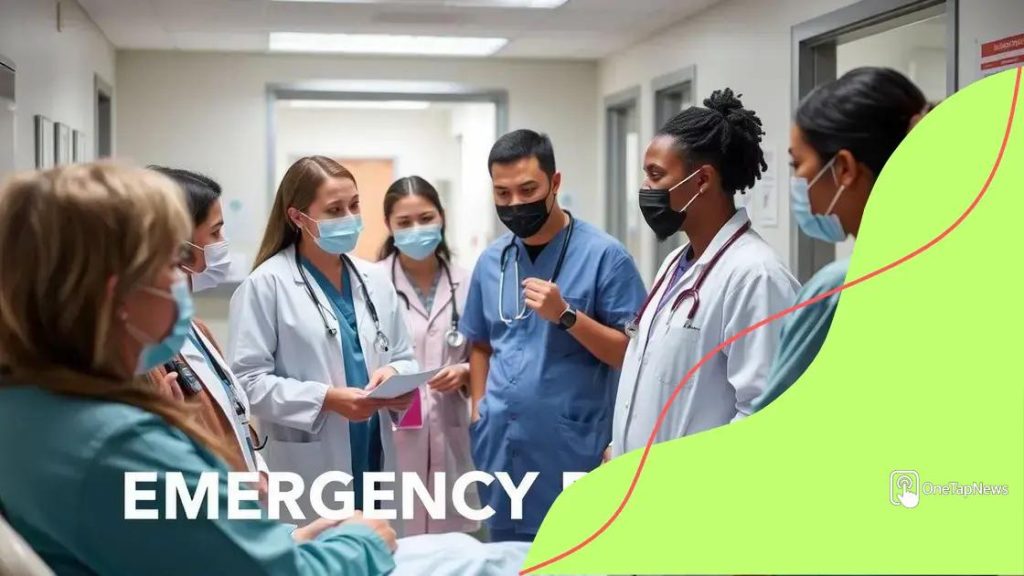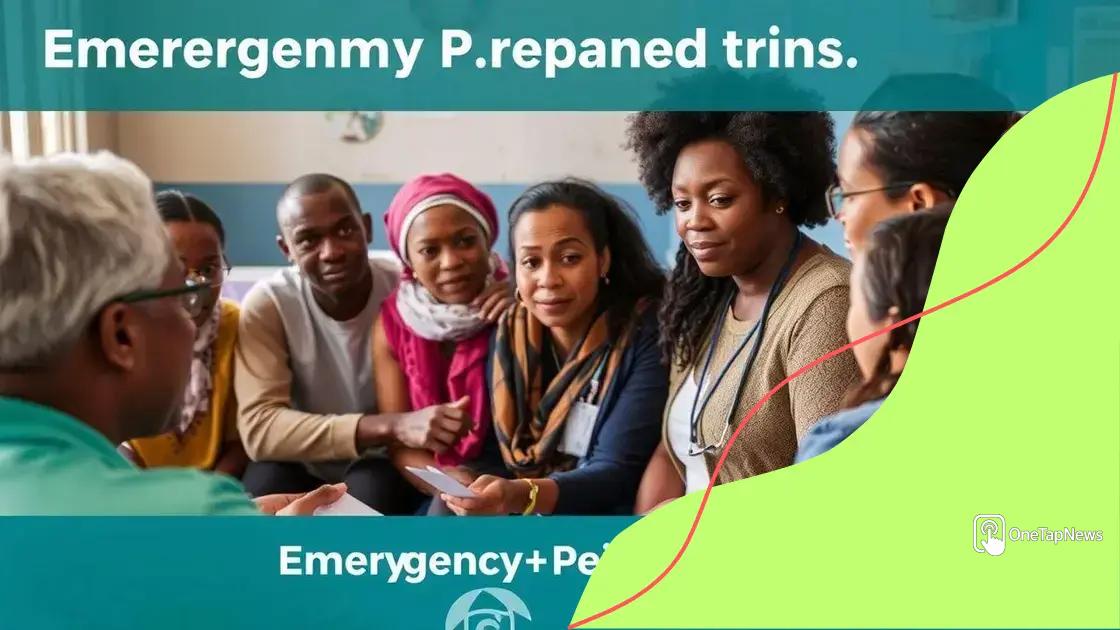Public health emergency preparedness: Are you ready?

Anúncios
Public health emergency preparedness involves coordinated planning and community engagement to effectively respond to health crises, utilizing technology and addressing both physical and mental health needs for a resilient response.
Public health emergency preparedness is something we all should think about. Have you ever wondered how your community would respond to a crisis? In this article, we will explore important strategies for ensuring safety and resilience in the face of health emergencies.
Anúncios
Understanding public health emergencies
Understanding public health emergencies is essential for everyone. These situations can arise unexpectedly, causing significant disruptions. They may include disease outbreaks, natural disasters, or bioterrorism incidents. Recognizing their nature is the first step in effective preparedness.
Types of Public Health Emergencies
There are various types of public health emergencies, each requiring specific responses. For example, infectious disease outbreaks can spread rapidly, impacting large populations. Natural disasters often strain healthcare resources, making it crucial for communities to be ready.
- Infectious disease outbreaks
- Natural disasters like hurricanes and floods
- Bioterrorism threats
- Environmental hazards
Understanding these categories helps communities prepare better. For instance, knowing that a flu outbreak might need different responses than a severe weather event allows for tailored strategies. These responses can include vaccination campaigns or emergency shelters.
Anúncios
Key Indicators of Public Health Emergencies
There are key indicators you should be aware of to identify when a public health emergency might be occurring. These indicators can help residents and officials react swiftly. Monitoring unusual patterns in health data or reported incidents can signal an emerging crisis.
- Rise in hospital admissions
- Sudden increase in illness reports
- Claims of health-related damage
- Official alerts from health organizations
Being alert to these signs can save lives. Public health authorities use these indicators to activate emergency plans. Community awareness is vital in contributing to the overall preparedness.
Key components of effective preparedness plans
Understanding the key components of effective preparedness plans is vital for any community facing public health emergencies. These plans serve as a proactive approach to reducing the impact of crises. They help ensure that necessary resources and actions are coordinated from the start.
Essential Elements of Preparedness Plans
Every effective preparedness plan should include several essential elements. These elements work together to create a comprehensive strategy that addresses various aspects of an emergency. First, risk assessment identifies potential threats. This is critical to determine the resources needed for a response.
- Risk assessment and management
- Clear communication strategies
- Resource allocation and logistics
- Training and drills for responders
Additionally, clear communication strategies are crucial. During an emergency, how information is conveyed can significantly impact community response. Establishing protocols ensures that everyone receives timely and accurate updates. Furthermore, resource allocation must be prioritized so that essential supplies are readily available.
Community Involvement in Preparedness
A successful preparedness plan also engages the community. Involving citizens fosters a sense of responsibility and readiness. Individuals should know their roles during a public health emergency. Regular training can help people understand what to do when faced with a crisis.
- Community education and outreach
- Involvement in planning processes
- Regular drills and exercises
- Feedback mechanisms for improvement
By encouraging community participation, preparedness plans become more effective. Stronger community ties can lead to quicker, coordinated responses, making a significant difference when emergencies occur.
Community roles in health emergency response

Community roles in health emergency response are crucial for effectively managing crises. Involving residents can significantly enhance preparedness and resilience during public health emergencies. When each person understands their role, the entire community benefits.
The Importance of Community Involvement
Communities that actively participate in emergency response plans tend to recover faster and more effectively. Everyone’s involvement is necessary, from local health organizations to individual volunteers. Those on the ground can learn what to do when an emergency strikes.
- Providing immediate assistance to neighbors
- Helping to disseminate important information
- Supporting local health departments
- Participating in training and drills
This active participation fosters trust and collaboration. It also builds relationships within the community, which can be vital during a crisis. Understanding the strengths and weaknesses of a community helps in preparing targeted responses.
Training and Education Support
Training is a key component of effective community response. Local workshops can increase awareness about health emergencies and how to respond to them. Informing community members about safety measures and communication strategies can save lives.
- Organizing first aid training sessions
- Conducting emergency preparedness workshops
- Creating informational pamphlets for the public
- Encouraging participation in local drills
By ensuring that everyone is informed and trained, communities can act more cohesively. This preparedness contributes to a rapid response that can minimize chaos and confusion when emergencies arise.
Challenges in public health emergency preparedness
Challenges in public health emergency preparedness can hinder effective response efforts during crises. Understanding these challenges is essential for improving strategies. Communities often face a range of barriers that can complicate preparedness efforts.
Resource Limitations
One significant challenge is the lack of resources. Many public health departments struggle with limited funding and personnel. This can prevent them from developing comprehensive emergency plans. Without adequate resources, training and necessary supplies may be insufficient.
- Insufficient funding for public health initiatives
- Lack of trained personnel to implement plans
- Inadequate supplies for emergencies
- Limited access to technology for tracking health data
Addressing these limitations is crucial for improving response times and overall effectiveness during health emergencies. Finding creative solutions and utilizing community resources can help bridge these gaps.
Communication Barriers
Another challenge is effective communication. During a public health emergency, timely information is vital. Misinformation or lack of communication can lead to widespread panic. Ensuring clear and accurate messaging before, during, and after emergencies helps maintain public trust.
- Language barriers within diverse communities
- Lack of access to reliable information sources
- Inconsistent messaging from health authorities
- Difficulty in reaching vulnerable populations
By improving communication strategies, communities can reduce confusion and enhance overall preparedness. Building a network of trusted sources ensures that everyone stays informed.
Future trends in emergency preparedness
Future trends in emergency preparedness are shaping how communities will respond to public health crises. As technology advances and new strategies emerge, it is crucial to stay informed about these developments. Understanding these trends can help communities enhance their resilience.
Emphasis on Technology
One significant trend is the increased use of technology. Mobile apps and online platforms are becoming essential tools for communication and information sharing during emergencies. Real-time data and alerts can keep communities informed and prepared.
- Mobile apps for emergency alerts and updates
- Data analytics for risk assessment
- Telehealth services for immediate medical support
- Social media for spreading awareness and gathering feedback
Utilizing technology helps streamline response efforts. It allows for quicker dissemination of information, ensuring that people know how to act during a crisis.
Focus on Mental Health
Another emerging trend is the recognition of mental health during emergencies. Health authorities are increasingly addressing the psychological impacts of crises. Support systems must be integrated into preparedness plans to help individuals cope.
- Training for mental health professionals in emergency response
- Community workshops addressing stress and anxiety management
- Resources for individuals affected by crises
- Collaboration with local mental health organizations
By focusing on mental health, communities can build stronger support networks. This promotes recovery and resilience, preparing people for future challenges.
FAQ – Frequently Asked Questions about Public Health Emergency Preparedness
What is public health emergency preparedness?
Public health emergency preparedness involves planning and coordinated efforts to respond effectively to public health crises, such as disease outbreaks or natural disasters.
Why is community involvement important in emergency preparedness?
Community involvement is vital because it enhances coordination, trust, and responsiveness during a crisis, ensuring everyone knows their roles and can act effectively.
How does technology improve emergency response?
Technology facilitates real-time communication and data sharing, enabling quicker updates and better resource management during emergencies.
What role does mental health play in emergency situations?
Mental health support is crucial as it helps individuals cope with stress and anxiety during crises, promoting overall community resilience and recovery.